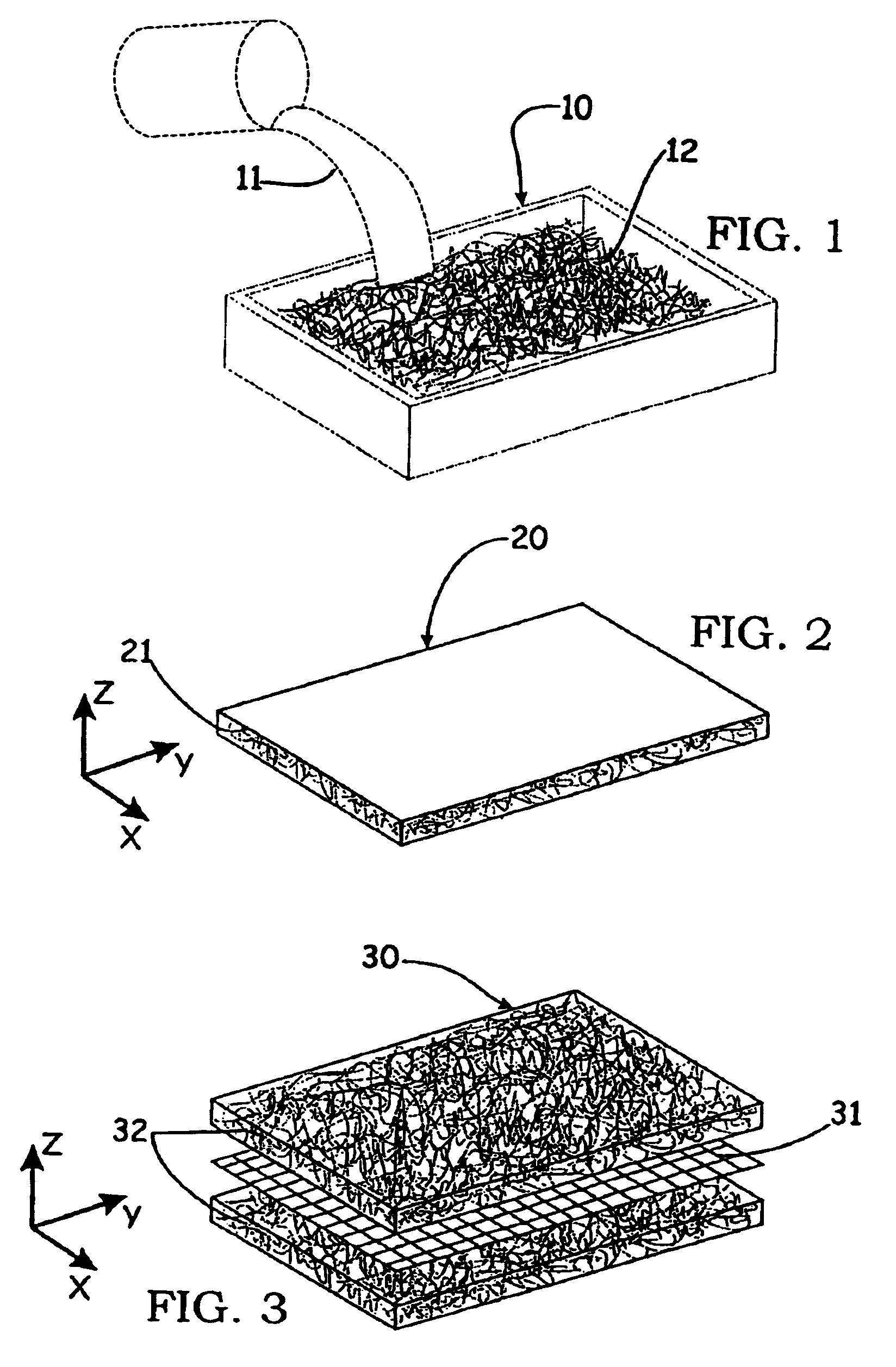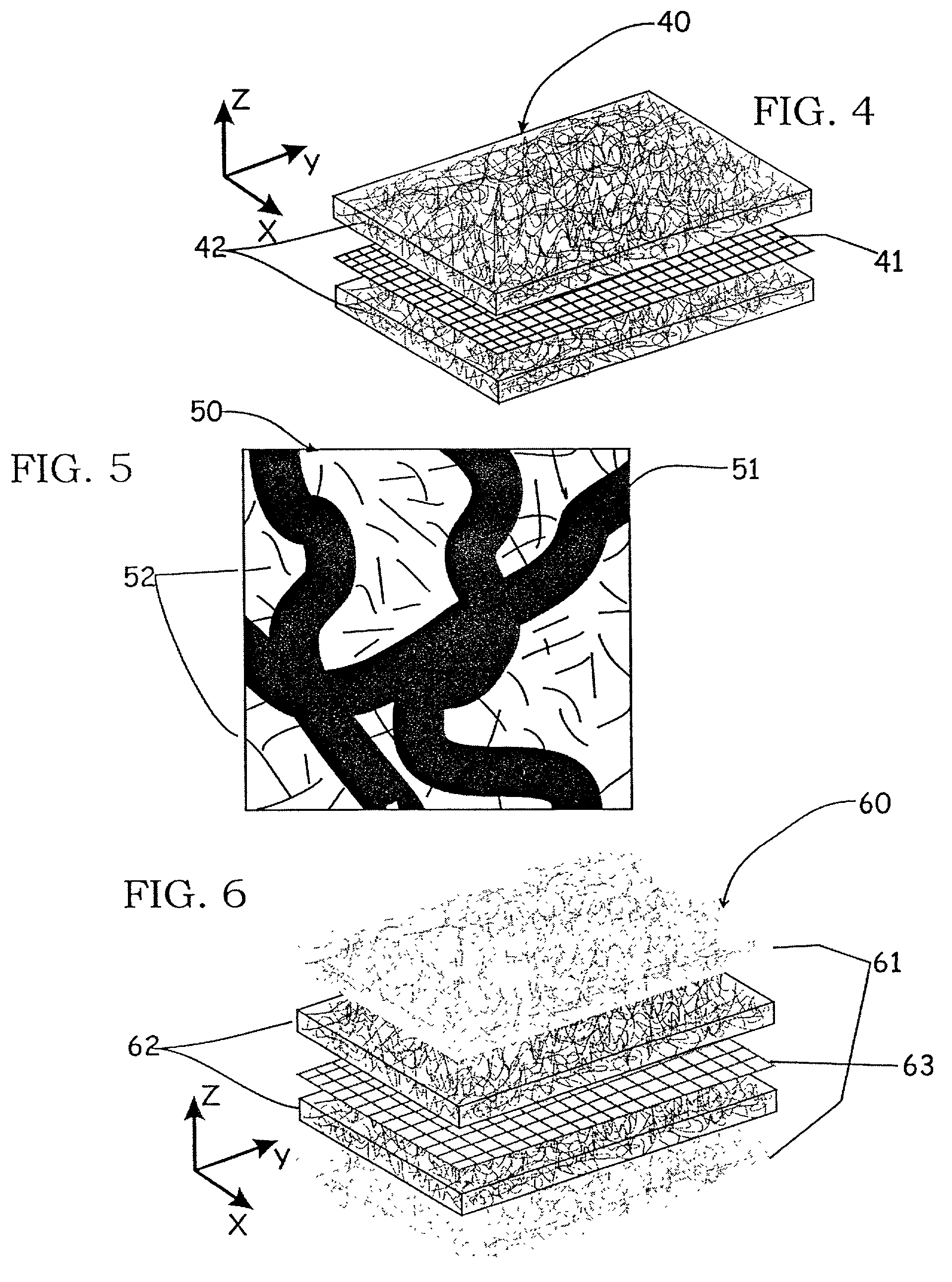Aerogel composite with fibrous batting
a composite material and fibrous material technology, applied in the field of aerospace composite materials, can solve the problems of relatively low thermal stability in air, unsuitable for most applications outside of the laboratory, and products quite stiff as manufactured, so as to improve the thermal performance of the composite material, improve the thermal performance of the aerogel, and minimize the volume of unsupported aerogel
- Summary
- Abstract
- Description
- Claims
- Application Information
AI Technical Summary
Benefits of technology
Problems solved by technology
Method used
Image
Examples
example 1
[0064]A section (2′×3′×¼″) of polyester Thinsulate® Lite Loft insulation from 3M Company was placed in a walled container. 1300 ml of a commercially available pre-hydrolyzed silica precursor (Silbond H-5) is mixed with 1700 ml of denatured alcohol, 95%. The solution is stirred for 15 min. The solution is then gelled by the slow addition of HF (2% by volume of the total solution) with stirring. The resulting solution is poured on the blanket previously placed in a container. Gelation occurs within a few minutes. The fresh “blanket-gel” is aged overnight in a sealed bath of ethanol at 50° C. The alcohol trapped in the gel is removed by subcritical and supercritical CO2 extraction over the span of four days.
[0065]The resulting aerogel composite has a density of approximately 0.1 g / cc. The thermal conductivity of the aerogel composite was determined by a Thin Heater Thermal Conductivity Test (ASTM C 1114-98) to be 16.6 mW / m° K. A pure aerogel monolith prepared using the same source mate...
example 2
[0068]The procedure of Example 1 is repeated except that the polyester fiber batting was replaced by a lofty silica fiber structure (Quartzel from Saint-Gobain Quartz) having a density of 65 g / m2 with a polyvinylalcohol binder.
[0069]The resulting silica batting / silica aerogel composite has a thermal conductivity of 15.0 mW / m-K as tested on a guarded hotplate (ASTM C-177). The flexibility of the composite is less than that of the aerogel-polyester blanket of Example 1, but still significant. It is quite flexible but does not drape to the same extent. The density of the aerogel composite was 0.113 g / cc. The thickness of the composite was approximately 3 mm. This composite resists thermal degradation when exposed to open flame much better than the product of Example 1.
[0070]Aerogel sintering appears to be minimized by the presence of the fiber. An oxyacetylene torch is placed 5–6″ below the sample with the top of the flame impinging on the bottom of the blanket. Minimal sintering is se...
example 3
[0071]The procedure of Examples 1 and 2 is repeated except that the reinforcement fiber batting is replaced by a 5 layer fiber laminate of polyester / silicon carbide / -16 copper mesh / silicon carbide / polyester).
[0072]The thermal conductivity (tested per ASTM C-177) is 12.5 mW / m-K (average). The composite is not very flexible. The thickness of the laminate is 10.3 mm. The copper mesh improves the x-y thermal conductivity by spreading out point loads over a larger area. The copper mesh also provides an EMI-RFI shield. Aerogel sintering appears to be minimized by the presence of the reinforcing polyester and silicon carbide fibers.
PUM
| Property | Measurement | Unit |
|---|---|---|
| Fraction | aaaaa | aaaaa |
| Fraction | aaaaa | aaaaa |
| Fraction | aaaaa | aaaaa |
Abstract
Description
Claims
Application Information
 Login to View More
Login to View More - R&D
- Intellectual Property
- Life Sciences
- Materials
- Tech Scout
- Unparalleled Data Quality
- Higher Quality Content
- 60% Fewer Hallucinations
Browse by: Latest US Patents, China's latest patents, Technical Efficacy Thesaurus, Application Domain, Technology Topic, Popular Technical Reports.
© 2025 PatSnap. All rights reserved.Legal|Privacy policy|Modern Slavery Act Transparency Statement|Sitemap|About US| Contact US: help@patsnap.com



